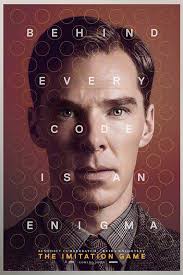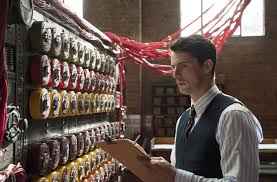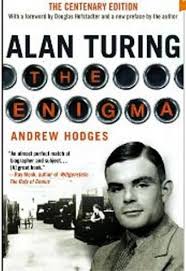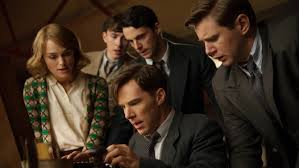 Writers Guild of America Awards bestowed the award in the adapted category onto Graham Moore’s script for The Imitation Game which also took the recent USC Scripter’s Award. Moore, a 31 year old, who worked as a sound engineer in the music business, floating around with musicians, bands, writers and filmmakers before writing a bestselling novel then screenplay, based The Imitation Game on the biography Alan Turing: The Enigma by Andrew Hodges.
According to an online interview, Moore met an acquaintance, Nora Grossman, at a party who told him she and her partner Ido Ostrowsky, pooled together their own money buying the rights to the first and most complete biography of Alan Turing. She said it was about “this mathematician, you’ve never heard of him.” However, he had heard of him and recalled his own obsession with computer science as a kid.
Writers Guild of America Awards bestowed the award in the adapted category onto Graham Moore’s script for The Imitation Game which also took the recent USC Scripter’s Award. Moore, a 31 year old, who worked as a sound engineer in the music business, floating around with musicians, bands, writers and filmmakers before writing a bestselling novel then screenplay, based The Imitation Game on the biography Alan Turing: The Enigma by Andrew Hodges.
According to an online interview, Moore met an acquaintance, Nora Grossman, at a party who told him she and her partner Ido Ostrowsky, pooled together their own money buying the rights to the first and most complete biography of Alan Turing. She said it was about “this mathematician, you’ve never heard of him.” However, he had heard of him and recalled his own obsession with computer science as a kid.
Moore goes on “–We’ve been talking about recording technology and being an engineer, and in the world of tech people, Alan Turing is a person of cult-like fascination. Alan Turing was a mid-century mathematician who arguably invented the computer. He was in his late twenties at Cambridge when the Second World War broke out, and he was recruited to run a chunk of cryptography operations for the British government. He was on the team that was tasked with breaking the German Enigma  machine, which was the code machine that the Germans used for all major communications. It was an impossible task. No one thought it could be done, and he did it, which meant that for the last two years of the war, the British were hearing everything the Germans were saying to each other. It ended the war years earlier than it would have otherwise. And it was top secret — no one knew what it was or who did it.” Obsession gets results.
machine, which was the code machine that the Germans used for all major communications. It was an impossible task. No one thought it could be done, and he did it, which meant that for the last two years of the war, the British were hearing everything the Germans were saying to each other. It ended the war years earlier than it would have otherwise. And it was top secret — no one knew what it was or who did it.” Obsession gets results.
In a 2010 New York Times review of The Sherlockian, the reviewer pinpoints these obsessive aspects of the promising young writer as “a new novel predicated entirely on Holmes worship, Holmes mimicry, Holmes artifacts and assorted other forms of Holmesiana. Its smart young author, Graham Moore, has done much more than fall into the fancy of Holmes’s existence. He has fallen down a Holmes well.”
Indeed. In 2011, Moore did the same with a story based on the book by Andrew Hodges, a mathematician whose meticulous work matches Turing’s brilliant mechanization of subtle logical deduction, also broken down into chapters in a documentary, Codebreaker. With the monumental research work done, a daunting task in itself, the adaptation of a story that rediscovers a character otherwise lost in history during a time of great inventiveness and early theoretical work in a field now known as computer science, is just as alluring as the white rabbit leading Alice down the rabbit’s hole.
mathematician whose meticulous work matches Turing’s brilliant mechanization of subtle logical deduction, also broken down into chapters in a documentary, Codebreaker. With the monumental research work done, a daunting task in itself, the adaptation of a story that rediscovers a character otherwise lost in history during a time of great inventiveness and early theoretical work in a field now known as computer science, is just as alluring as the white rabbit leading Alice down the rabbit’s hole.
Moore recalls, “I became obsessed with this idea that his (Turing’s) cryptographic work and his computer work is him dealing with the issues of being a closeted gay man —A literal storytelling device. A spy thriller about the war, and mathematics, and computers and gender relations and sexual identity. He was a difficult man, but he wasn’t a sad sack, he was a willful man. It’s like all the movies in one movie: There’s a spy story, a war story, an unbelievable story about what it meant to be a closeted gay man in the 1940s and ’50s, and in the military.”
It’s a compelling story. Described as the story of British wartime cryptographer Alan Turing, who cracked the Enigma code and later poisoned himself after being criminally prosecuted for his homosexuality, it presented an optimum personal writing exercise that Moore acknowledges as a way to write for this particular obsession– writing a monologue opening. He explains, “it’s an exercise I’ll do where I’ll write a monologue from the main character’s perspective, where I’ll have him or her talk about what they think the point of the piece the reader is about to see is— as if they were going to narrate. I’ll do a couple of pages, just for the sounds. The sound of the writing really matters to me — how people are talking. It’s about rhythm, the cadence. It was just the lead character talking. Part of my technique, of just writing a monologue from his perspective, finding a voice for him that I really loved.” Makes sense, especially from a former sound engineer and musician. It’s something that is done in musicals going back to Gilbert and Sullivan’s success and Mr. Gilbert’s credited ability to direct actors singing the dialogue.
Having such monologues in dialogues might have caused producer reluctance to take on the project. A costly before, during and after Second World War period piece, electronic technology and theory succintly explained, government doctrines and decisions, social issues and personalities that are kept secret for seventy years. Authenticity becomes paramount for loyalists. After many draft revisions, The Imitation Game landed the #1 spot at the top of the “Black List” (best unproduced scripts in Hollywood) in 2011. A formidable project, it was finally taken on by director Morten Tyldum who discussed the lengthy pages of monologue at a Q&A following a New York Women in Film & Television screening presentation. The Turing character challenges were enormous and that’s where the Norwegian director and lead actor come in– identifying and projecting the emotion. Benedict Cumberbatch immerses himself as Turing and Tyldum’s European sensibilities and filmmaking roots find ways to locate and bring to surface complex layers of elements where a viewer’s own deduction speaks the words in the story. Deftly handled, subtext runs throughout.
In Subtext Speaks: How to Write Effective Movie Script Dialogue, subtext is explained: as what a character is really saying between the lines. It is revealed by a character’s actions and reactions and all content underneath that is not announced explicitly by the characters but understood by the viewer. Subtext can be found not in the words, but instead we see it beneath the spoken lines. Conflict, anger, happiness, guilt, envy, pride, any emotion can be acted, shouldn’t be explained and definitely not through dialogue. Scenes work, not because it was spelled out for us, but because of the subtext. Every character needs to pursue something– something specific. Then the writer gives us two plus two, but lets us do the math– that way we feel smart when we solve the equation.
Additionally, when writing dialogue, a good line sums up all forces acting upon a character at a particular moment. True subtext comes from weaving multiple dramatic forces into the words that you have, not from merely cutting the words that you don’t need. There were plenty of editing and interweaving elements from the three basic storylines– Turing’s unhappy childhood and his only friend, Christopher– love and loss; war time and breaking the Enigma code– loss and gain; and lastly, the break-in and exposure– building a computerized brain before losing it all. Subtext is the result of the many facets spoken throughout in one line. Sometimes more than that can be followed but the weaker aspects might get lost in the larger arc of the line. Often it’s not immediately apparent when the subtext bends in a path of the line. It’s rewarding when you get it.
 As Andrew Hodges expressed in his book, the Alan Turing story has truth about a troubled life with a tragic ending. Kudos for bringing such a story to life by the tenacity of believers from literary agents, producers, low budget independent filmmakers. Archival footage and film editing by William Goldenberg added to the wonderfully solid supporting actors– Keira Knightley, Matthew Goode, Rory Kinnear, Allen Leach, Matthew Beard, Charles Dance and Mark Strong. Music by Alexandre Desplat that perhaps Moore was likely more involved in as well as writing the monologue puzzle leaving clues behind for appreciative audiences. Compelling, elementary and computable.
As Andrew Hodges expressed in his book, the Alan Turing story has truth about a troubled life with a tragic ending. Kudos for bringing such a story to life by the tenacity of believers from literary agents, producers, low budget independent filmmakers. Archival footage and film editing by William Goldenberg added to the wonderfully solid supporting actors– Keira Knightley, Matthew Goode, Rory Kinnear, Allen Leach, Matthew Beard, Charles Dance and Mark Strong. Music by Alexandre Desplat that perhaps Moore was likely more involved in as well as writing the monologue puzzle leaving clues behind for appreciative audiences. Compelling, elementary and computable.



02/15/2015
Featured